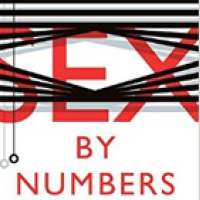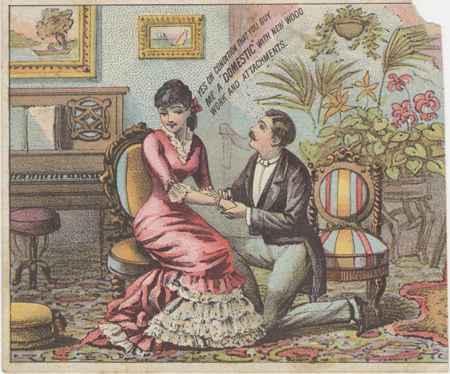
Sexual statistics
Watch the full interview with Spiegelhalter in this video or listen to it as a podcast.
Straight men have had twice as many sexual partners, on average, as straight women. Sounds plausible, seeing that men supposedly think about sex every seven seconds. Except that it's mathematically impossible: in a closed population with as many men as women (which roughly there are) the averages should match up. Someone is being dishonest, but who? And why? These questions, along with many others, are explored in Sex by numbers, a new book by David Spiegelhalter, Winton Professor for the Public Understanding of Risk at the University of Cambridge.
"Sex is a great topic," says Spiegelhalter. "There's lots of it going on, but we don't know what goes on or how much of it, because most of the time it goes on behind closed doors. It's a really difficult topic to investigate scientifically, and a real challenge for statistics." Spiegelhalter's aim is to get people interested in a critical approach to the numbers they hear about in the news and give them the tools to figure out if they can be believed. "It's really a book about statistics, using sex as an example."
Statistics about sex are not all equally good. Some, like the number of births in a given year, are cast-iron facts, but others are much harder to come by. The number of sexual partners is a good example. The mismatch above comes from the third The National Survey of Sexual Attitudes and Lifestyles (Natsal), conducted between 2010 and 2012, in which men reported having had 14 sexual partners, on average, and women 7. Studies have suggested that women give lower numbers when they fear the survey isn't entirely confidential, something that doesn't seem to affect men (contrary to my expectation, it doesn't induce them to exaggerate). So that's one possible explanation for the mismatch: sadly, women still need to fear social stigma.
But there are other explanations too. One is that men (more than women) may have some of their sexual experience with sex workers. These aren't included in the surveys, so their experiences are missing from the female tally. Another is that there are different attitudes as to what counts as a sexual partner. If a woman feels she's been coerced by a man, for example, she may not want to count him.
Star-rated
It's clear that, to get at the truth, surveys about sexual behaviour need to be designed and analysed very carefully. Spiegelhalter ranks sexual statistics using a star-rating. Four stars are for numbers we can believe because they are straight-forward to count — the number of births, or registered sexual diseases, for example. Three stars are for numbers from well-designed surveys, such as Natsal. "[The people behind Natsal] try hard to get a random sample of people, to get many people to respond, to make sure people answer accurately by insuring confidentiality, etc. Those surveys are pretty good; I'd say they are accurate to about 20%."

More ropey studies, for example internet panels, get two or one stars, depending on the effort they make to present a balanced picture. One problem here is that the people who take part select themselves, so while you might be getting a good cross-section of the users of a particular website, you're unlikely to get one that represents the entire population. You'd expect a different set of answers from readers of Loaded than The Lady.
Zero stars go to numbers that are completely made up. "There are some lovely 19th century examples about the terrible harm of masturbation; or that having an orgasm is equivalent to losing so many ounces of blood," says Spiegelhalter. It seems that the modern idea of men thinking about sex every seven seconds is made up too. It's hard to find out the correct answer, but scientists have tried anything from giving people clickers to press whenever they are thinking about sex, to calling them up at random times to ask them if they were. None of those studies confirmed the seven seconds myth. "It varies enormously amongst people," says Spiegelhalter. "You find that people think more about food than they think about sex."
Boy boom
Even four-star statistics can raise puzzles. For example, British birth statistics show that more boys were born in the years 1919 and 1945 than in any other year since 1837, and the same goes for other countries too. "It's a four-star, incontrovertible fact that more boys are born at the end of wars," says Spiegelhalter. That's amazing: there is obviously a dire shortage of males at those times, but how does that lead to more baby boys being born? "There's the Trivers-Willard hypothesis, which says that, by some mechanism, females can to a small extent control the gender of their offspring to be most suitable to the environment," says Spiegelhalter. "The suggestions is that boys are needed, so women pop them out. But I find that idea deeply suspicious."
Another suggestion is that boys are a result of more sex. "It's pretty uncontroversial to think that at the end of wars, when soldiers come home, there is going to be pretty intense sexual activity. More babies were born in 1919 in this country than in any other year, so we know there's a lot of sex." A lot of sex means that women tend to get pregnant early on in their menstrual cycle — if you are having sex all the time you are likely to get pregnant at the earliest opportunity. "There is a theory which says that babies conceived early on in the cycle tend to be boys. This isn't very well-explained, but there are quite plausible hormonal reasons for why it might be the case." So there's a possible explanation for why there are more boys born at the end of wars. And, conversely, the fact that there are provides some evidence for the theory that early conception produces more boys.
Victorian sex

A decidedly unerotic courtship. This is a Victorian trading card advertising sewing machines.
Amazingly, all this also points to an answer to another great mystery of statistics and sex: why did the Victorians stop having babies? "In the 1850s Victorians used to have five or six babies [per couple]. By the start of the twentieth century this was reduced to two," says Spiegelhalter. "There was a massive reduction of fertility in this country, without there being any contraception." Historians have argued a lot about why this reduction occurred. Abstinence was promoted fiercely by the Victorians, of course, but did people really take the message into their bedrooms, having less sex and producing fewer babies?
"It turns out that when you plot the sex ratio, you see that the proportion of boys being born dropped steadily during the end of the Victorian period, reaching absolute rock-bottom around 1898 to 1900," says Spiegelhalter. "Proportionally more girls were born than in any other time in history in those years. But if more boys means more sex, then more girls means less sex! This suggests that sexual activity was dropping throughout the Victorian period, reaching rock-bottom around the turn of the century."
Disgusting sex
Maybe you can't really blame the Victorians for being prudes. With all those body parts and slimy liquids, sex is really quite disgusting. Why do we even do it? This, too, is a question science hasn't shirked. "One idea is that sexual arousal might reduce your disgust response," says Spiegelhalter. "So there has been this great experiment. The investigators randomly allocated people to watch different kinds of videos. One was sexually arousing — a bit of soft porn — one a very neutral video, say a train journey, and another was of an exciting activity such as sky diving. Then they asked people to do various disgusting things. Sticking a pin into a cow's eyeball; handling [supposedly] used tissues or panties, or putting their hand in a bowl of apparently used condoms. (The investigators had a very vivid imagination of disgusting things.) And what they found is that people who'd just seen the arousing film were more willing to do these disgusting tasks."
Spiegelhalter's book is not dissimilar to those arousing videos. It's designed to lower your statistics threshold, so that hopefully you become more willing to engage with those numbers. But whatever your attitude to statistics, if you're interested in sex, you'll definitely enjoy this book.
Comments
Anonymous
The statistical 'impossibility' suggested in the first paragraph is perfectly feasible. Consider a population in which men engage in sex more frequently than women. Then each man might have sex with two women, but each woman with only one man. In combination with some other
statistic (e.g., that the number of sex acts per person in the same for both sexes) there might be a problem, but not the partner information alone.
Marianne
Yes, this result might not be immediately obvious, but here's a proof https://plus.maths.org/content/average-number-sexual-partners
Anonymous
It's *not* impossible for men to have had more sexual partners than women in a closed system. You just need a large number of people (enough so that no one can have sex with all sexual partners) and for a few women to have many more male sexual partners than other females.
Marianne
Yes, this result might not be immediately obvious, but here's a proof https://plus.maths.org/content/average-number-sexual-partners
Anonymous
I just read your explanation on equal averages and then this text.
I don't understand how you can talk about a "closed" system in this case if men in your statistics might count encounters with "sex professionals" in the number of partners they give. But on the other hand, the female "sex professionals" were not asked (as you stated in the text).
For me that means the system is not closed. As the group of possible sex partners for men is much larger (female professionals & amateurs (haha ;)). But the women asked are only the "amateurs".
At the same time, I don't have any numbers, but I think observation in this case is enough: the number of women going to male "sex professionals" is tiny.
What am I missing? I think most men would count those encounters with the professionals even if you ask them not to ;)